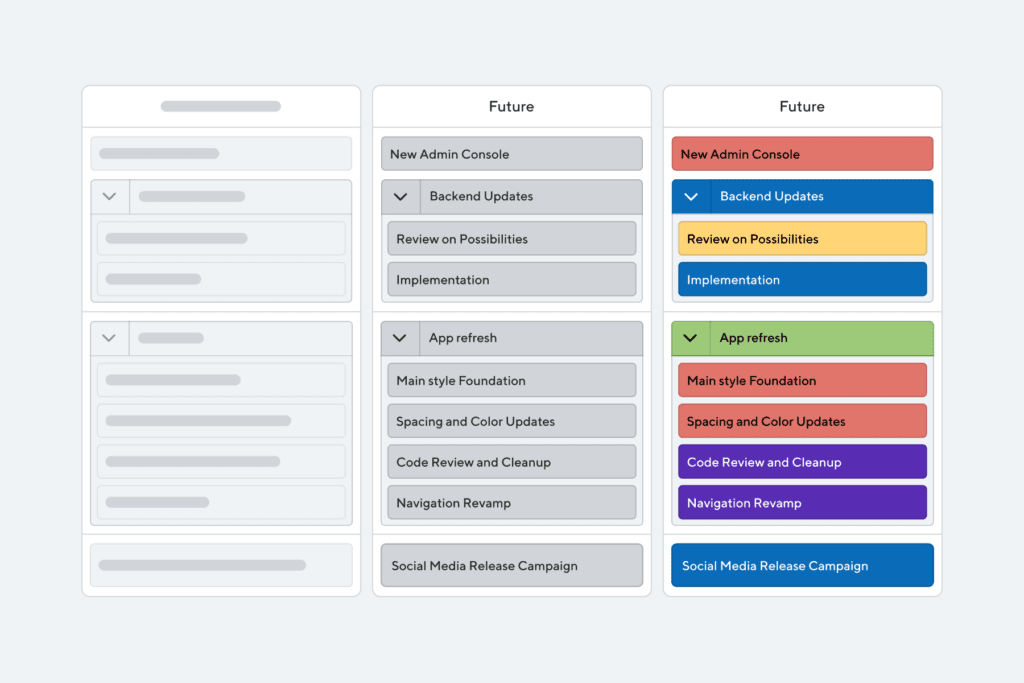At its most basic level, a customer-led product strategy means that your customers are the top priority at all times.
Sounds pretty obvious, right? But creating a truly customer-centric business model means balancing a lot of different factors, not just customer service. All too often, customers are losing out to more influential stakeholder groups and other priorities.
One report found that 80 percent of customers said the experience a company provides is just as important as its products or services. Therefore, it makes total sense to look at the products you offer from the customers’ perspective.
Ensuring your products and services bring joy to customers at every stage of their journey will help grow your business, helping it survive even in tough times.

Putting Customers First
Any time you launch a new idea, a new product, or a new system, ask yourself the following questions:
#1 Who will this serve?
#2 How will it benefit the people it serves?
#3 What are the company’s goals for this product or service?
By asking – and answering – these questions, you can create something that people truly value.
Anticipating the kind of products customers need and making sure they get them will lead to deeper brand loyalty and customer retention.
But first, you need to know exactly what the customer wants to deliver it. Making use of key customer insights and then implementing them is vitally important.
For example, if you discover that most customers want to receive their purchases in the fastest possible time, you could use retail inventory management software to speed things up.
Remember that 81 percent of consumers are willing to increase their spend with an organization in return for a better experience!
Looking at the Data
You might think you’re pretty hot on knowing what your customers want, especially if you’ve been running a successful business for many years.
However, here’s a sobering statistic: 80 percent of companies believe they are delivering a superior customer experience, but only 8 percent of customers agree! This proves that you shouldn’t claim to be customer-centric if your products and services don’t reflect that.
Digital technology means there are now more avenues for observing customer behaviors and spotting crucial insights – and statistics suggest that insight-driven customer experiences help businesses retain 89 percent of their customers.
By blending data from customer surveys with qualitative and observational insights, you can build a detailed profile of your target users and see their needs.
It’s also helpful to note what your competitors are up to and look at non-competitors to get an idea of best practices. You don’t have to copy their approach, but you can tease out the best bits and blend them into the perfect strategy for you.
Creating a partnership with a competitor can actually aid the customer journey in some cases. If you cannot offer a product or service that your customer really wants, put your rivalry to one side and team up with a company that can!

Making a Plan
Once you’ve taken a look at the improvements you could make, it’s time to produce your plan of action. This framework should always put the customer front and center while ensuring any changes are viable within your overall business model.
Product roadmaps are useful in planning and development and can be used to create alignment across the organization. Start with the product vision statement, then set out your goals and initiatives.
The customer-led product strategy must be ingrained at every level of your company, so all your employees need to understand who the product is aimed at, what its unique selling points are, and what the long-term goal should be. Having your customer service and marketing departments work together is a good way to boost the customer experience.
Hiring the right people, who truly believe in your vision, is crucial – as is keeping them up to date and motivated. Using video conferencing software can help maintain face-to-face contact with those in other sectors of the business.
Adapting to Change
The digital environment has created a definite shift in customer behavior, meaning that customers become more discerning and impatient in the products and services they choose.
They now have higher expectations and more choice than ever before – so if you don’t meet their needs, they can just as easily go elsewhere. New technology might make it easier for you to communicate with customers, but it’s also easier for them to complain!
Older businesses, in particular, can struggle to adapt to the new pattern, compared to newer companies and start-ups with millennials at the helm. But it’s basically a case of “adapt or die.” Companies that consistently find innovative ways to develop and market their products will succeed in the long run.
Tapping into Technology
One prediction is that by 2021, there will be over 230 million digital shoppers in the United States.
The role of technology affords many opportunities to provide a superb customer experience and gain customer insights at all the different touchpoints.
The automation of customer service is one such element, and we’re seeing businesses introduce improvements like a call recording service to make life simpler for both customers and agents.
Meanwhile, the rise of artificial intelligence can give extra insights into the customer experience using smart chatbots and analytics.
Technology will only increase in importance, but you should make sure it is always useful to the customer and helps rather than hinders their journey! For older customers and more traditional businesses, the latest tech may not necessarily be the best solution for booking appointments, where it has advantages and disadvantages.

Making it Personal
A customer-led product strategy means learning which products appeal to customers and viewing them as much more than mere transactions. However, just offering them excellent products and an enjoyable, hassle-free experience isn’t enough.
Personalization is the real key, as it makes customers feel like they are genuinely valuable to the business. Finding ways to personalize both the product and the overall journey will boost customer retention – and a happy customer will share their positive experiences with others, thus enhancing your rating on product review sites.

It goes without saying that you should deliver a great omnichannel experience as standard. Still, it also helps to give customers personalized support as they browse and hopefully make a purchase. Customers appreciate little details, such as adding extra filters to narrow down browsing choices and save time.
A customer-facing product roadmap can be used to let individual customers know what you’re up to and how you’re implementing their feedback, helping you to build a deeper relationship.
You can encourage employees to develop empathy for the customers by talking to new service users and regular visitors if a customer has decided to switch to a different company, try to find out why – and see if there’s a way to tempt them back in.
Maintaining Momentum
A customer-led product strategy means you need to be proactive instead of reactive. Make sure you ask the necessary questions before the customer embarks on their experience, thereby keeping in control of the process.
Once a customer has been convinced to create an account, the onboarding system is crucial in executing your product strategy. You could keep them coming back by creating personalized messages or offering free trials or discounts on products you’ve learned that particular customer would like.
The importance of website maintenance cannot be overstated if you want customers to choose you over your competitors. Ensure your whole online presence is optimized to give all users the best experience on whatever device they use, including personalized product suggestions and plenty of up-to-date, relevant content.
The eventual aim is that happy customers will keep returning, so you won’t have to spend so much on marketing and sales activities – especially great news for smaller businesses.






